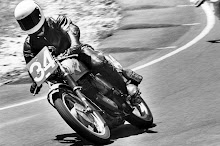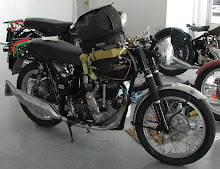Thanks for dropping in so regularly, revisit again in early 2010, I've a lot of interesting items in the pipeline.....
I'm off to Eastern Canada. the Miramichi in New Brunswick Province to be a little precise with Mrs DQ......
Brrrr I hear you say....Bloody oath I agree with you, but family calls and we have accepted a long standing invitaion to spend Christmas with my son-in-law's family.....
But what of this blog.......??
Thought I'd start an item on the Smiths SSM Speedometer and RSM tachometer......
Firstly what do the initials mean?
SSM is "speedometer shallow magnetic" and the tacho RSM is obvious.....
The shallow refers to the previous Smiths magnetic instrument the SN and RN type or "Nemag" instrument and this new magnetic instrument was shorter in height, hence the "shallow" reference....
They were introduced in 1963 in 60mm diameter case size for what are deemed Lightweight motorcycles....250cc and under, and the dials were usually a shade of grey and the scale often 60mph and 80mph, although later in the 1960's and early 1970's this instrument was supplied in 120mph, and 150mph/180kph for the single cylinder range of Ducati motorcycles ....the 350/350/450 versions.
The speedometer and tacho were called the 2000 series... i.e SSM2001/00, used amongst other things on the BSA C15 and D7 BSA Bantam.
Left click on the illustrations to enlarge.....
Acknowlegements to Mortons Motorcycle Media and Smiths Motor Accessories for items used....

The Smiths Chronometric instrument had become an expensive instrument to produce and was labour intensive, and with the major motorcycle manufacturers compaining of supply costs, Smiths produced an 80mm diameter version for the end of the 1963 season.

The 80mm diameter type, often refered to as 3" instruments, but Smiths were metric in their chronometrics and continued this into the SSM/RSM at least with the bezel rim and case.
They were initially offered in a grey dial, with a lighter grey circle in the centre with white concentric circles and of course numerals....
Known to one and all as Smiths "greyface" instruments.
Black dials with white numerals appeared later in the 1960's and illustrated is a batch of 80mm SSM and RSM instruments I built for Ducati 750/900 bevel drive motorcycles for a Japanese customer years back.


Illustrated is a speedometer and tachometer from a Velocette Venom Thruxton 1966/67.... the red sector was discontinued by Smiths by 1968. Again rebuilt by me.

So how do you get into these RSM and SSM instruments.....??
You can use a screwdriver, carefully manipulating under the rolled edge of the chromed bezel, levering against the case. However you can expect to see marks on the case via this method...bit annoying if the case has been painted. We paint our cases after the instrument is dis-assembled.
In this case Mrs DQ is doing the honours....

A better idea if you've a few to do, or are an instrument repairer and are curious as to how others do it is to purchase a pair of German made, Knippex brand "mirror/glass breaking pliers" and grind the ends suitably.... they work like a charm...
The original Smiths bezels were brass, pressed out and chrome plated...with time the brass, under stress from the pressing will split and you often see "new old stock" instruments with radial splits on the bezel edge. I bought hundreds over the years and often got caught, and of course needed to roll on a new bezel rim.
This means with this splitting, that it is almost impossible to re-use an original bezel after you manipilate it off.
We made our bezels in 0.7mm thick, half hard copper sheet and chromed onto it. Big advantage is that you can remove and refit the bezel several times without it looking horrible or splitting.



Rolling on the bezel is for another day, but illustrated is the Smiths factory tool......
























